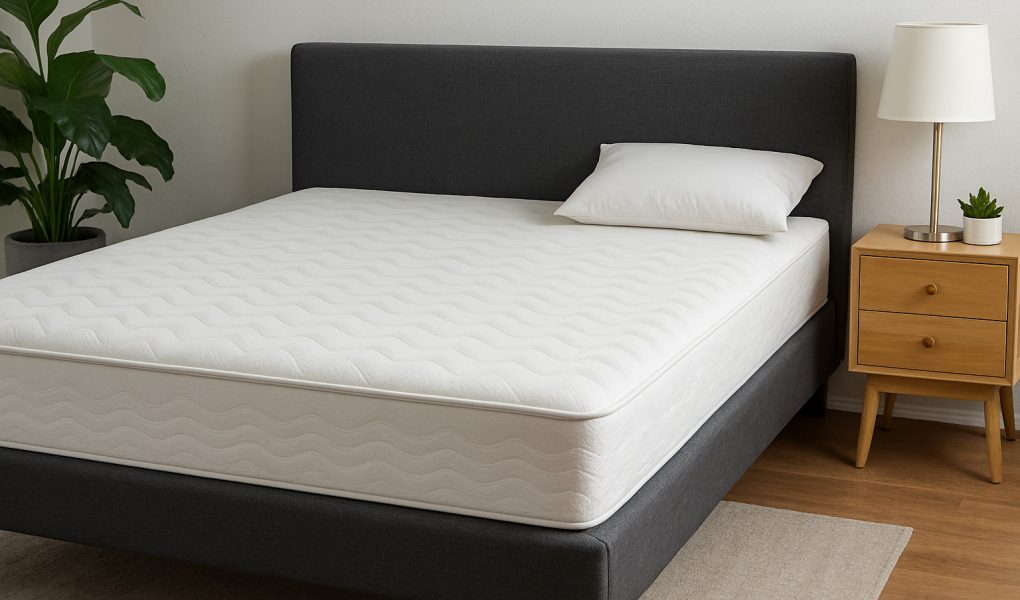A mattress isn’t just a purchase—it’s a commitment to your well-being. The wrong one can leave you tossing, turning, and waking up with aches. The right one aligns your spine, supports your body, and helps you wake up rested. Here’s a structured way to choose the right mattress based on sleep position, body type, materials, and more.
1. Match Your Mattress to Your Sleep Position
The way you sleep directly impacts which mattress will provide the right support and comfort.
Side Sleepers
- Need a softer to medium-firm surface.
- Helps cushion shoulders and hips.
- Promotes spinal alignment by letting pressure points sink slightly.
Back Sleepers
- Require a medium-firm to firm mattress.
- Supports the natural lumbar curve.
- Prevents the lower back from sagging.
Stomach Sleepers
- Should stick to firm mattresses.
- Prevents the midsection from sinking.
- Keeps the spine from arching unnaturally.
Combination Sleepers
- Benefit from a medium-firm feel.
- Balances support and comfort for all positions.
- Reduces the need to adjust during the night.
2. Consider Your Weight and Body Type
A mattress that works for one person may not perform the same for another due to weight and how the body sinks into the material.
- Lightweight sleepers (<150 lbs):
- Often find better contouring and pressure relief on softer surfaces.
- Firmer mattresses may not compress enough to feel supportive.
- Average-weight sleepers (150–250 lbs):
- Medium-firm options usually provide the best mix of support and comfort.
- Mattresses that adapt across pressure zones are ideal.
- Heavier sleepers (>250 lbs):
- Need firmer, denser support to avoid excessive sinkage.
- Hybrid or latex mattresses designed for higher weight ranges perform better long-term.
3. Understand Firmness—Beyond the Numbers
Firmness affects comfort, but it’s subjective. A mattress rated a 6 on a 10-point firmness scale might feel different depending on your frame and sleeping habits.
- Side sleepers: Should feel the waist supported without the hips rising too high.
- Back sleepers: Should be able to slide a hand under the lumbar curve with slight resistance.
- Scale ratings: Helpful but inconsistent between brands. Use them as a reference, not a rule.
A medium-firm mattress often performs best in clinical trials for reducing back pain and improving sleep quality.
4. Know the Materials and What They Do
Each mattress type brings different benefits. Knowing the material construction helps predict comfort, temperature control, and longevity.
Innerspring
- Bouncy, breathable, and responsive.
- Best for those who want more traditional support.
- Generally affordable but lacks body contouring.
Memory Foam
- Molds to your body shape.
- Provides excellent pressure relief and motion isolation.
- Can trap heat unless infused with cooling gel or breathable layers.
Latex
- Naturally resilient and breathable.
- Offers good contouring without the “sinking” feel of memory foam.
- Durable—natural latex can last up to 25 years.
Hybrid
- Combines coils with foam or latex layers.
- Designed to offer the best of both: bounce and contouring.
- Typically supportive and longer-lasting.
Adjustable Air Mattresses
- Air chambers allow for adjustable firmness.
- Great for couples with different firmness preferences.
- Useful if your needs change over time.
5. Sleep Features That Matter More Than You Think
Buying based on firmness alone can miss other critical features that affect sleep quality.
- Spinal alignment: The mattress should keep your head, shoulders, hips, and heels in a straight line.
- Pressure relief: Especially for side and combo sleepers, cushioning over joints prevents soreness.
- Temperature regulation: Sleep hot? Opt for latex, hybrid coils, or gel-infused foams.
- Motion isolation: Light sleepers sharing a bed should prioritize memory foam or motion-reducing hybrids.
- Durability: Foam mattresses last 8–10 years, while natural latex may outlast most other types.
- Hypoallergenic materials: Latex and some specialty foams resist dust mites and mold naturally.
6. The Buying Process: What to Expect
Buying a mattress today can be done online or in-store, but the process benefits from some ground rules.
- Test it in-store: Lie down in your preferred position for a few minutes. Don’t just press it with your hand.
- Look for trial periods: Many companies offer 90–365 day in-home trials. This is the only way to know if it truly works for you.
- Understand warranties: Know what is covered and for how long. Sagging thresholds and stains can void some warranties.
- Set your budget wisely: Price does not guarantee comfort. High-cost mattresses may include premium materials, but that doesn’t always translate to better sleep.
7. Don’t Buy a Pillow Until You Pick the Mattress
The height and firmness of your mattress affects how much support your neck needs. A firm mattress may call for a thicker pillow, while a soft one will let your head sink more. Matching the pillow to the mattress ensures neutral neck alignment.
A mattress should support your sleep—not disrupt it. Focus on how it matches your body and sleep style, not the marketing jargon. A well-chosen mattress won’t just help you fall asleep faster, it’ll make you want to stay asleep longer.



